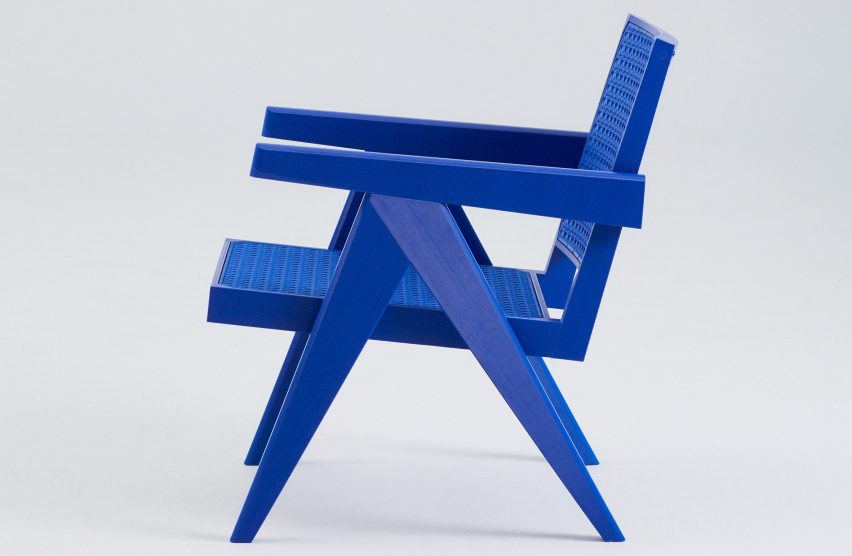Designer Benjamin Fainlight has created a flat-packed, 3D-printed version of Pierre Jeanneret's Easy Chair that was originally created for the city of Chandigarh in India.
The designer decided to reimagine the Easy Chair to demonstrate how seminal furniture designs could be dissected and updated, much like streetwear has been doing with fashion.
"I saw a lot of streetwear designers and brands seeping into the furniture world – Virgil Abloh x IKEA and Vitra, Supreme x Knoll and so on," explained Fainlight.
"But they were really just changing colourways, materials or upholstery, and not necessarily reimagining the furniture pieces in the way streetwear tends to subvert and recontextualise references," he told Dezeen.
"I wanted to challenge myself to apply a really direct streetwear methodology to furniture and create something totally new instead of just re-skinning something that already existed in some form."
Fainlight focused on reworking the Easy Chair, as it was a well-known historic piece that had the potential to be given a modern twist.
The wooden chair with a cane seat was originally designed by Pierre Jeanneret in the 1950s for civil servants working in the city of Chandigarh and developed largely in collaboration with his cousin Le Corbusier.
"I wanted to work with a design that was iconic, had a backstory to its existence and popularity, and most importantly was handcrafted, since my version would be the antithesis of handcraftsmanship," said Fainlight.
"The Easy Chair seemed to fit that brief perfectly – its wood fabrication made it easily translatable to plastic, the angularity of the chair made it doable – though not easy – for slicing into flat-pack pieces, and the caned panels for the back and seat gave it a texture and dimension to show what's feasible with 3D printing."
Fainlight wanted to transform not just the colour of the chair, but how it was constructed and shipped.
According to the designer, 3D-printing the updated Easy Chair and making it so that it can be flat-packed clearly marks the design as a modern piece, as does the choice of International Klein Blue (IKB) as its colour.
"More than anything else I think flat-packing is the most modern way for furniture to exist. I wanted to show that flat-packing isn't necessarily a determining factor in the quality of design or importance of a piece, but can be a uniting factor since everyone is familiar with it – just like a T-shirt is to streetwear and clothing," said Fainlight.
"I wanted to use a colour that was so incredibly unnatural, the chair could never be mistaken for something handmade or using materials found in nature," he continued.
"IKB seemed like the perfect hue to strive for since there's a certain utopian consistency across everything in that colour."
Fainlight believes that the redesign and its method of construction provides a commentary on contemporary furniture design.
"I think it speaks to the world we live in today, where anyone with a 3D printer and enough time on their hands could take an icon and make something totally new from it, or something totally new as a whole," he explained.
"Design and fabrication aren't limited to people with degrees or years of experience in the field and can be democratised for everyone's involvement."
Pierre Jeanneret worked extensively with his cousin Le Corbusier, whose real name was Charles-Édouard Jeanneret. At Chandigarh, Pierre Jeanneret master-planned large areas of housing and was given the title chief architect of the city.
He collaborated with Le Corbusier on the design and furnishings of many of the city's major public buildings including the Capitol Complex.
Photography is by Sam Sklar.

